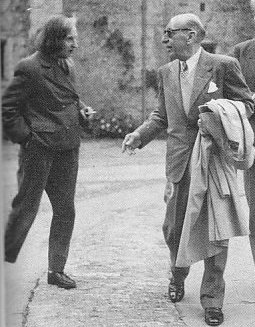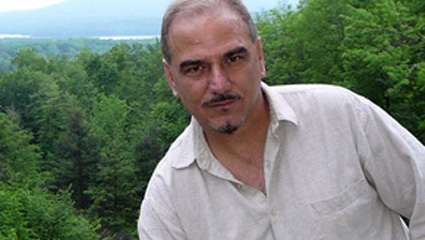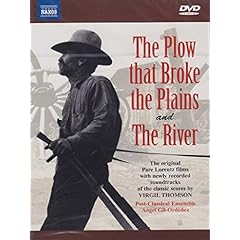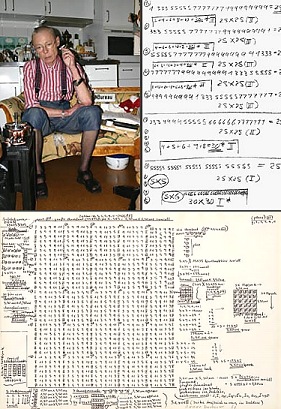 Five minutes before Elisabeth Lutyens appeared live on BBC Radio 4’s ‘Start the Week’ in 1979 she threatened to denounce Russell Harty as a ‘homosexual interviewer’ if he mentioned the phrase ‘lady composer’; thankfully Harty avoided using the words when the programme was on air. Lutyens was a larger than life personality who pioneered serial techniques in her unfairly neglected music. She was also well connected as my photo shows. For the full story, and a recommendation of a new CD of her music, click on Walking with Stravinsky.
Five minutes before Elisabeth Lutyens appeared live on BBC Radio 4’s ‘Start the Week’ in 1979 she threatened to denounce Russell Harty as a ‘homosexual interviewer’ if he mentioned the phrase ‘lady composer’; thankfully Harty avoided using the words when the programme was on air. Lutyens was a larger than life personality who pioneered serial techniques in her unfairly neglected music. She was also well connected as my photo shows. For the full story, and a recommendation of a new CD of her music, click on Walking with Stravinsky.

We’re a little late in reporting this, but last month composer George Tsontakis was awarded the Charles Ives Living by the American Academy of Arts and Letters. I had never heard of this prize before, but it’s a sweet deal. Tsontakis receives $75,000. each year for three years provided that he forgo all normal paid work. He may, however, accept commissions. The Charles Ives Living was established by Ives’s widow with royalties from her late husband’s music. This round the selection committee was chaired by none other than William Bolcom. The previous three winners were Stephen Hartke, Chen Yi, and Martin Bresnick.
Can we agree that between this and the Grawemeyer Tsontakis is on a serious roll these days? I think we can.
Otherwise things look pretty quiet here today. I’m taking over the daily post here for two weeks as Jerry sees to some Top Secret S21 Business. Stay tuned . . .
Our regular listen to and look at living, breathing composers and performers that you may not know yet, but I know you should… And can, right here and now, since they’re nice enough to offer so much good listening online:
Hidayat Inayat-Khan (b.1917 — India / Europe)

Taken mostly from the 1981 Cambridge International Biographical Centre entry, I just have to give you a good taste of this very interesting bio:
Hidayat Inayat-Khan’s great-grandfather, Mula Bux, founded the first Academy of Music in India in the 19th century, and also invented the music notation system carrying his name. Born in 1882, Professor Inayat Khan, father of Hidayat Inayat-Khan, was the greatest classical musician in India in his time. He wrote several books, among them ‘Minca-I-Musicar’, the first treatise on Indian music. His first historical Western concert was given on 9 April 1911, in the Hindu Temple of San Francisco. Later, in Russia, he met Scriabin. In 1913 Lucien Guitry organised Professor Inayat Khan’s first concert in Paris, where Claude Debussy was also inspired by the charm of Indian music. It is reported Professor Inayat Khan gave Claude Debussy lessons in Vina playing.
Hidayat Inayat-Khan was born in London on 6th August 1917, and was cradled in an atmosphere of Indian music. His western musical education began in 1932 at the Ecole Normale de Musice de Paris, in the violin class of Bernard Sinsheimer; the composition class of Nadia Boulanger; and the orchestra class of Diran Alexanian. Later, he attended chamber music courses given by the Lener Quartet in Budapest. In 1942 Hidayat Inayat-Khan became Professor of music at the Lycee Musical de Dieulefit, France, and later in Holland joined the orchestra of Haarlem as violinist. In 1952 He conducted the orchestra of Hertogenbosch for the broadcasting of his Poème en Fa for orchestra and piano, in a world-wide program, and, in the same year, founded his first chamber music orchestra ensemble.
Significant occasions in Hidayat Inayat-Khan’s professional life include the playing, on 4th May 1957, of his Zikar Symphony at Salle Pleyel, Paris. On the occasion of Mahatma Gandhi’s centenary, on 21st November 1969, Hazrat Inayat Khan’s Gandhi Symphony was played in a special concert organized by UNESCO in Holland. This was also played in 1971 during a broadcasting of ‘The Voice of America’, as well as on the United Nations Radio in the USA and was later recorded by the US Armed Forces Radio Stations in a world-wide Carmen Dragon show. In 1988 Hidayat Inayat-Khan assumed the role of Representative-General of the Sufi Movement International and Pir-o-Murshid of its Inner School. He divides his time between Holland and the family home in Suresnes, but travels extensively, giving classes and lectures on Sufism.
I didn’t see a death-date; if not he’s still pushing 90 this year. The Sufi Petama Project hosts an extensive site dedicated to Hidayat Inayat-Khan, including MP3s of a number of his works (and links to places to buy CDs of this rather rare stuff). On the left navigation, head to the Quartet op. 48 first; starting somewhere in Delius/Debussy land, by the third movement rolls around (which mysteriously expands the quartet to full string orchestra) you’ll be strongly reminded of Hovhaness. Then give his Ziukar Symphony or Message Symphony a go. If it all sounds up your alley, my work is done… If not then never fear, I’ll head back into experimental territory next outing!
 For those of you who were insufficiently cheered by Florida’s decisive surge over the Ohio State football factory, here’s something that should help. Our friends at Naxos will release on January 31 a DVD of fellow Mountaineer Pare Lorentz’s landmark New Deal-era documentaries “The Plow that Broke the Plains” (1936) and “The River” (1938), featuring the first complete modern recordings of the seminal Virgil Thomson soundtracks by Washington, D.C.-based Post-Classical Ensemble under Angel Gil-Ordóñez, with narration by Floyd King.
For those of you who were insufficiently cheered by Florida’s decisive surge over the Ohio State football factory, here’s something that should help. Our friends at Naxos will release on January 31 a DVD of fellow Mountaineer Pare Lorentz’s landmark New Deal-era documentaries “The Plow that Broke the Plains” (1936) and “The River” (1938), featuring the first complete modern recordings of the seminal Virgil Thomson soundtracks by Washington, D.C.-based Post-Classical Ensemble under Angel Gil-Ordóñez, with narration by Floyd King.
“The Plow that Broke the Plains,” which examines the causes of the Dust Bowl drought and was made for $20,000, was the first film produced by the United States Government for commercial release. Despite being rejected by the film distribution system as New Deal propaganda, the documentary reached people in over 3,000 theaters. “The River,” which addressed flood control on the Mississippi River, won Best Documentary honors at the Venice Film Festival and received a Pulitzer Prize nomination for its script. It is probably unfair to call Lorentz Roosevelt’s Leni Riefenstahl but his films demonstrated the power of documentary to influence opinion.
Virgil Thomson’s soundtracks to both movies rank among the composer’s greatest work and also set the trend in the 1930s and 1940s for a new style of film music. A young Aaron Copland found the scores to be “fresher, more simple, and more personal” than most Hollywood soundtracks, “a lesson in how to treat Americana.”
Hey, somebody start some trouble over on the Composers Forum page.
Well, I see Chamber Music America is having its annual conference in the Center of the Universe this week, beginning on Thursday. I wasn’t invited this year. Last year, Alex Shapiro and Drew McManus and I did a dynamite panel on blogging to an SRO room. Alex and Drew were wonderful and, frankly, I thought I was pretty damned clever but three or four people complained on their evaluation sheets that I had said rude things about our esteemed President. Or, maybe, it was the part where I took a picture of the room and said I had been asked to do so by the National Security Agency. Kind of thing that has kept me out of the big time.
Who wants to review a new Charlemagne Palestine recording? Don’t say yes if you’ve been a disappointment to me already.
I was reading my copy of pinknews.uk this morning and came across this story about the forthcoming civil partnership ceremony of the composer Sir Peter Maxwell-Davies and his partner, Colin Parkinson.
Back in July, nine students associated with AAIR, the independent radio station of London’s Architectural Association School of Architecture, spent several days recording natural and man-made sounds to create an extensive sonic map of Capri, the island, not the car or the pants. The result is Radiocapri.
Now they’re inviting all of us to “remix” the sounds of the island in their cleverly named “International Remix Competition A.” Here’s the best part: the winning entry will be picked by Brian Eno, Arto Lindsay and Ryuichi Sakamoto.
The winner will get fame, fortune and more attractive lovers, plus a spot on an upcoming Radio Anacapri recording. Deadline is January 31. Details are here.
Mark Swed wrangled himself a trip to Budapest and came back with a brilliant piece on the world that shaped György Kurtág.
From the CBC:
Toronto composer James Rolfe has won the $7,500 Jules Léger Prize for New Chamber Music for his contemporary work raW, the Canada Council for the Arts announced Thursday.
raW, written during the buildup to the American invasion of Iraq in 2003, won the award designed to encourage the creation of new Canadian chamber music. It was chosen from a field of 115 new compositions.
The work “was written by filtering J. S. Bach’s Second Brandenburg Concerto through Bob Marley’s War (first movement), Burning Spear’s The Invasion (second movement), and John Philip Sousa’s Stars and Stripes Forever (third movement),” Rolfe said.
Does anybody remember who I gave Lee Hyla’s latest CD to review? Hope it wasn’t Evan since he’s wandered off somewhere until February. If it was somebody else, please review it because I promised.
I have a bunch of new stuff lying around although some of you still owe me from last year. How about this one: John Cage’s Postcard from Heaven for 1-20 harps?
Our regular listen to and look at living, breathing composers and performers that you may not know yet, but I know you should… And can, right here and now, since they’re nice enough to offer so much good listening online:
Hanne Darboven (b. 1941 — DE)

What better way to mark a new year than with something that is only and utterly about time, history and the march of events (or their stubborn recurrence)!
Only one piece to listen to, but it’s a full hour-plus. Darboven’s Opus17a for solo double bass was composed in 1996 for her massive artwork “Kulturgeschichte 1880–1983”, shown at the Dia Center for the Arts in New York. Played here with almost superhuman concentration and doggedness by Robert Black, it’s a piece guaranteed to either absolutely fascinate, repel or bore you to tears, depending on who you are.
The artist Hanne Darboven was born in Munich. Following a brief episode as a pianist, she studied painting in Hamburg. Between 1966 and 1969 she lived intermittently in New York City, then returned to her family home in Hamburg, where she continues to live and work.
Why and how does a visual artist turn to musical composition? The progression makes perfect sense as described in the essay by Lynne Cooke:
…[Darboven’s] work has been informed by Conceptual art practices. Based by the late 1960s on various forms of numerical writing, her systematic work securely occupied the realm of abstraction and universality.
“I only use numbers because it is a way of writing without describing. . . . It has nothing to do with mathematics. Nothing! I choose numbers because they are so constant, confined, and artistic. Numbers are probably the only real discovery of mankind. A number of something (two chairs, or whatever) is something else. It’s not pure number and has other meanings.”
Time has become the focus of Darboven’s art. For her, Annelie Pohlen argues, time constitutes the primary and essential structure of human life — it is “a basically intangible measure for the totality of the indices determining being; it is the content of consciousness; it exists beyond human comprehension.” The calendar, which subsequently formed the foundation of Darboven’s art practice, again offered a universal orientation, embodying a given, prefabricated, ready-made temporal system. Calibrated in her work in many ways over almost three decades, it has provided the basis of an arbitrary artistic system that has the appearance of objectivity. Conjoining a rigorous numerical process with free-associative roots, and tight rational thought with intellectual freedom, Darboven’s capricious sense of time has resulted in diverse monumental works that may span a month, a year, even a century, all recorded day by day.
In the early 1970s Darboven introduced a kind of writing into her work that took the form of an even cursive script. Although executed by hand, this script was standardized and regulated, systematic and abstract. […] In 1973 she began to incorporate texts—transcribed directly because, she has claimed, they could not be bettered— from various writers, initially Heinrich Heine and Jean-Paul Sartre. These texts spoke both to her recognition of the failure of the grand narratives of Enlightenment thought to provide convincing, encompassing interpretations and, equally, to her fundamentally romantic existentialist position. Then, in 1978, she introduced visual documentation alongside her numbers and looping texts, primarily in the form of found and rephotographed images, which allowed her to address specific historical issues for the first time. Shortly thereafter, she invented a system of musical notation, based on her system of numbering dates, which she has used since 1979 to compose scores for organ, double bass, string quartet, and chamber orchestra. Darboven sees her music as she does her “mathematical writing,” a highly abstract language functioning in an entirely self-referential manner; it thus serves as an abstract correlative to the concrete, visual nature of her artwork.

For articles on every one of the contemporary composers pictured above, and more, click on Overgrown Path’s People of the Year for 2006.